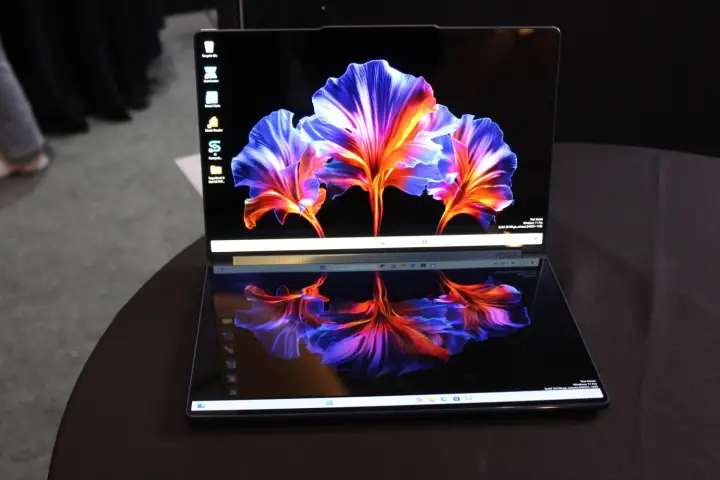
At CES 2025, Lenovo has announced one of the most interesting laptops I’ve ever seen, the ThinkBook Plus Rollable. It starts out as a fairly typical-looking 14-inch Lenovo laptop, but with the push of a dedicated key or the gesture of a hand, the screen can actually extend up to a 16.7-inch display that’s taller than it is wide. In around 8 seconds, the screen rolls up from the hinge, keeping the webcam at the top. You can hear the motor moving as the screen is unrolled.
The aspect ratio starts out at 5:4 for the 14-inch panel, and then extends out to 8:9, adding 50% more screen real estate. The idea with more vertical space is to let you see lots of extra cells in a spreadsheet, the full length of a webpage, or even two apps one above the other. The panel itself is actually a flexible 18-inch panel with a 2.6K resolution, but not all of it visible.
Leave it to Lenovo to actually deliver on a concept laptop like this. While there have been plenty of prototypes and demos with rollable OLED displays (including Lenovo’s own prototype from 2023), Lenovo has made a real product out of it, and after seeing it in person, I’m happy to report that it looks fairly refined. It even has a 120Hz refresh rate, and the OLED screen goes up to 400 nits.
There’s a real use case here too. A 16.7-inch laptop can be quite the burden to carry around — heck, it might not even fit in your bag properly. But the rollable OLED on the ThinkBook Plus Gen 6 gives you that flexibility — in theory. The screen does mean the device needs to be a bit thicker, and it measures in at 0.78 inches. It’s not huge, but it’s definitely thicker than your average ThinkBook laptop.
The trade-off is worth it because this laptop is just plain fun, though. I tried using the hand gesture to make the screen extend, which feels magical. Is it the most practical thing in the world? Maybe not. But what a party trick!
Aside from the rollable screen, this is otherwise a fairly standard laptop to launch in 2025. It’s powered by an Intel Core Ultra Series 2 chip, and it can be configured with up to 32GB of RAM and 1TB of storage. It also has a 5-megapixel camera and a 66 watt-hour battery. Those are solid specs for what could have been a purely gimmicky laptop.
Combine this device with the spinning AI Twist laptop that was shown off at IFA last year, and all the wacky experiments done with extra displays in the ThinkBook Plus line, and it’s easy to sayLenovo is leading the industry in innovation and interesting engineering — even if they end up just being prototypes or niche products. Just look at the company’s transparent laptop from last year.
Speaking of which, Lenovo has also updated its Yoga Book 9i, the company’s dual screen laptop. The device was first announced last year at CES, so it’s great that it was able to find enough of an audience to stick around. In it’s second generation, the Yoga Book 9i gets slightly larger OLED screens — each now 14 inches — while also shrinking the thickness and weight of the device. The two screens also have a 120Hz refresh rate and can be cranked up to 500 nits. Lenovo also says the screens have a 94% “active aspect ratio,” which would be a 2.1% increase from the original Yoga Book 9i.

Lastly, the Yoga Book 9i now comes with a larger 88 watt-hour battery.
The Yoga Book 9i will have an expected starting price of $1,999 and will begin shipping in May. The ThinkBook Plus Rollable will start at $3,499 and be available sometime in the first quarter of 2025.







